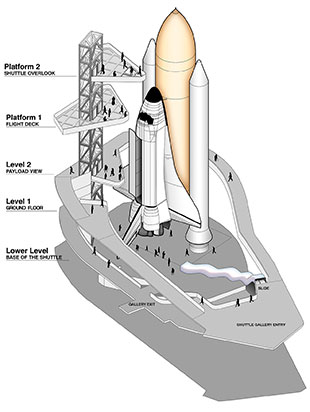January 10, 2017 — The space shuttle Endeavour exhibit at the California Science Center is getting a "boost" in the form of two very large, flight-worthy additions.
Orbital ATK and NASA are donating a pair of solid rocket boosters for the Los Angeles museum's vertical display of the retired orbiter. The two boosters, together with NASA's last existing built-for-flight external tank, will be mounted to Endeavour in the Science Center's new Samuel Oschin Air and Space Center, creating the world's only fully-authentic exhibit of a space shuttle in its launch configuration.
"We take great pride in our 30-plus years of participation in the space shuttle program," said Charlie Precourt, the vice president and general manager of Orbital ATK's Propulsion Systems Division and former space shuttle astronaut, in a statement provided to collectSPACE. "We are pleased and honored that we can contribute to this amazing exhibit at the California Science Center."
The 149-foot-tall (45 meter) solid rocket boosters produced most of the thrust needed for the space shuttle's first two minutes of flight. After expending their propellant, the twin boosters separated from the vehicle and descended under parachute to a splashdown for their recovery and reuse.

Concept drawing of the California Science Center's vertical exhibit of Endeavour, including twin boosters. (California Science Center) |
Orbital ATK is using most of its leftover space shuttle solid rocket motor hardware to support NASA's Space Launch System (SLS) heavylift vehicle. The next-generation rocket will use two boosters — each with an additional fifth fueled segment, as compared to the shuttle four-segment version — to launch missions beyond low Earth orbit, to the vicinity of the moon and to Mars.
The California Science Center was awarded Endeavour in April 2012, one year after the retirement of NASA's shuttle fleet, and has exhibited it horizontally in its Samuel Oschin Display Pavilion for the past four years.
Prior to Orbital ATK's donation of the inert but flight-worthy hardware, the Science Center had planned to use a pair of solid rocket boosters that had previously been displayed at the Kennedy Space Center Visitor Complex in Florida from 1994 to 2011. Those rockets, which had been built from a combination of flight and test components, as well as mock parts, were trucked to NASA's Armstrong Flight Research Center at Edwards Air Force Base in California in 2012 for possible use with Endeavour.
After NASA awarded ET-94, the last existing flight external tank, to the Science Center in 2015, it became evident that a flight-worthy set of solid rocket boosters were critical for the planned display — not only to maintain authenticity, but to also ensure seismic structural safety.
Dennis Jenkins, the director of the Samuel Oschin Air and Space Center Project for the Science Center, approached Orbital ATK with the request and it was granted.

Two solid rocket booster aft skirts were recently delivered to NASA Armstrong Flight Research Center for Endeavour's vertical exhibit. (California Science Center/Dennis Jenkins) |
"As for the non-motor parts of the boosters, we sourced a set of two flight-worthy aft skirts and frustums from NASA surplus and a set of forward skirts that were used for tests for NASA's SLS program that are currently at Orbital ATK in Utah," said Jenkins in a statement.
"Orbital ATK and NASA are providing most of the smaller parts, like booster separation motors, from surplus," stated Jenkins.
The aft skirts and a frustum were delivered from Kennedy Space Center to the Armstrong Flight Research Center in December. At the same time, the Science Center released one of the two previously delivered display boosters to the Pima Air & Space Museum in Tucson, Arizona, where it is now on display.
The delivery date for the flight-worthy boosters from Orbital ATK has not yet been set. Construction of the Samuel Air and Space Center in Los Angeles is expected to begin this summer, in support of the vertical space shuttle Endeavour exhibit opening in 2019.
